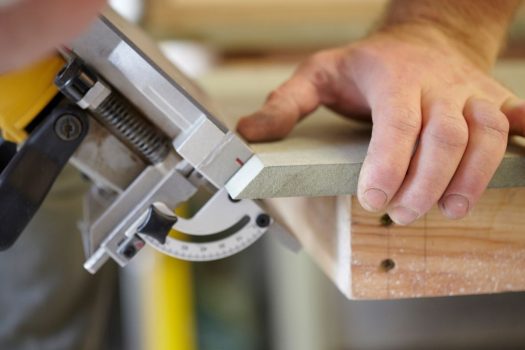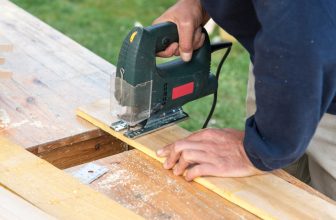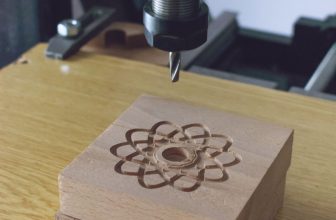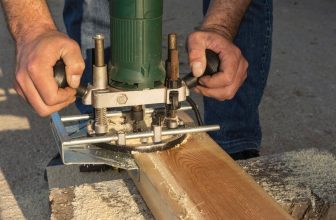Contents
Biscuit joiners are tools you might have heard of, but what do they do – and are they worth the time?
Because you don’t want to be without a tool that could make your woodworking life a lot easier – but you also don’t want to waste hard-earned money on a gimmick that you’ll never use.
If you’re unsure whether you need a biscuit joiner or if one would be a waste of money, hopefully, this article will help you make an informed decision!
What Is A Biscuit Joiner?
A biscuit joiner is a woodworking tool that’s used to help connect two pieces of wood together. They work by cutting a recess into pieces of wood being joined. These recesses are then filled with a slice of wood called a biscuit, which works much like a dowel.
A biscuit joiner will have a circular blade – it’s essentially the same blade you’d find on a circular saw but smaller.
This blade cuts a recess into the piece of wood far more quickly and cleanly than could be done by hand – a powered circular saw can remove a lot more material in a much shorter time than could ever be done by hand tools.
And, as they’re so quick, this means that they can be used to save a lot of time and effort in joining and aligning boards.
The “biscuits” are flat ovals of wood. They slot into the crescent-shaped holes made by the circular saw, allowing you to align two pieces of wood together to be joined easily.
These biscuits are a little smaller than the slots they fit into, meaning that the pieces of wood have a little room to be moved to get the alignment right. You’ll cover the biscuits in wood glue before placing them into their slots, which is essential to getting any pieces of wood to hold together.
What Can I Use A Biscuit Joiner For?
They can be handy tools in some circumstances. They can be instrumental in some situations for helping to align boards. As long as you make sure to accurately place the slots so that the panels will be in the right place when put together, you can use a biscuit joiner to save you a fair bit of time and effort.
This could be especially useful if you have to align many pieces or if you’re dealing with long panels. Having slots cut in the right places and biscuits put in them can make lining these panels easier and getting a flush and seamless join easier.
Depending on the type of work you’re doing, you might find that a biscuit joiner is used quite often. If you’re building cabinets or tabletops, a biscuit joiner could be used to help you make sure that everything is aligned correctly.
And if you’re doing a lot of repetitive work where getting the alignment of boards right is key, you could find that a biscuit joiner makes the job easier for you.
What Don’t Biscuit Joiners Do?

While biscuit joiners have their uses, they’re not tools that can be used for every situation where you need to join two pieces of wood together! There are a few things that they’re not so good at.
Firstly, they don’t add very much strength. Compared to a butt joint, they will likely be more robust, but not often by very much – and they’re not as strong as a dowel.
The biscuits are pretty thin and also a little loose in their slot – so if you haven’t got enough glue in to fill this gap, the biscuit might not be doing much for the bond’s strength.
They’re no match for an authentic joint, either. A real joint, such as a dovetail or mortise and tenon, will always be more potent than a biscuit joint. Depending on the needs of your work and aesthetic considerations, these joints might not always be possible to use.
If you don’t want visible joints, then a biscuit joint can help you to achieve that – but it’ll never be able to match the strength of an authentic woodworking joint.
They’re not a replacement for your own eyes, skill, and judgment when it comes to aligning boards. They can make the job easier, but at the same time, if you’re not paying attention, you can easily make life more annoying for yourself by getting the placement of the slots wrong.
The biscuit joiner won’t let you do much that you can’t do without it – you’ll still need to do the alignment work yourself. It’s just that a properly used biscuit joiner could help you get the job done quicker, providing you already know what you’re doing.
They’re not always as precise as you might like either. Especially on older joiners or inexpensively made ones – you might well notice that the slots aren’t as precisely cut as you’d like, and the whole thing doesn’t make life as easy as you’d expected.
Even with these limitations, they can still be valuable tools in the right hands, with a job that’s of good use for them. However, for a lot of woodworking, the same can be done with other tools – and even if a biscuit joiner is helpful for your job, it’s no replacement for your own eyes and hands.
Do I Need One?
If you have a job or a project where a biscuit joiner will be helpful for you, then they’re worth considering. Depending on your use case, a biscuit joiner might well help you to save yourself time and effort to get your job done.
This will be especially true in professional circumstances – if there’s a job that a biscuit joiner helps you to perform more quickly and with more ease, then they can be a tool that can make you money!
However, they’re probably not a tool that every woodworker needs. They fill a niche, but not everybody needs a tool that fills that niche – and they don’t do anything that can’t be accomplished by other means.
There are countless ways to combine two pieces of wood – and you’re always better off learning how to use tools you already have to accomplish a task rather than buying a tool for just one job.
In short, if your woodworking needs will be made easier with a biscuit joiner – and if they can help you make money more easily – they can be great tools. However, they’re no replacement for woodworking skills, and the job they do can often be achieved in other ways, using much cheaper tools.
Are They Useless?
They’re not useless, but they’re far from being the most versatile tool you could ever own. For some people, they’re essential tools – something they use every day and maybe even use to earn money.
For other owners of biscuit joiners, they’re just another surface collecting dust in the workshop.
For most use cases, you’re probably better off learning alternative ways of doing what a biscuit joiner does. Not only will you save a lot of money (as most woodworking skills don’t need costly tools), but you’ll also learn some precious skills in the process.
All a biscuit joiner will teach you is how to use a biscuit joiner!
If you’re already using a biscuit joiner as part of your job, then it’s very possibly a tool you wouldn’t want to go without. But they’re a little gimmicky for most use cases – not something you’ll find yourself using often enough to justify the money they cost.
Conclusion
Whether you need a biscuit joiner or not, the most important thing is to ensure that you’re using the tools you need for the job and not to worry about what others use – after all, you’re the one doing the hard work!







